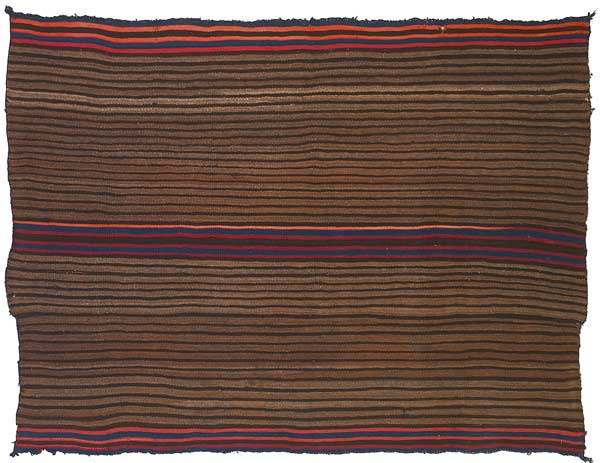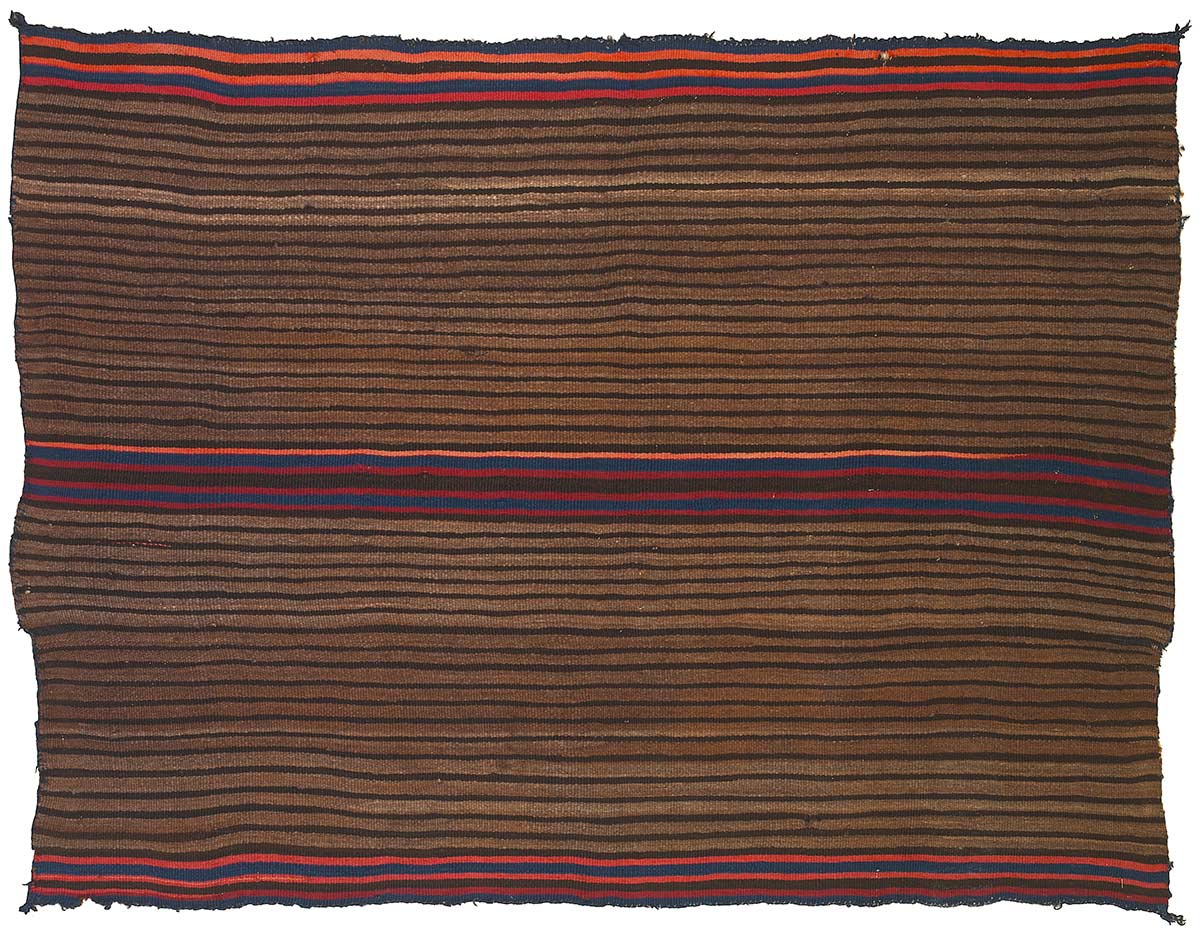#3. A Late Classic First Phase Chief’s Blanket, Woman’s Style, Navajo, circa 1865, also known as the Goodenough Red Line First Phase. The first phase measures 43 inches long by 58 inches wide, as woven.
The first phase is in the collection of the American Museum of Natural History, New York, by donation from Sarah Elizabeth Goodenough (1900-1989), of Monmouth County, New Jersey. [AMNH Catalog #50.2 / 4751].
The first phase’s dark red, medium red, and coral pink stripes qualify it as a red line first phase, as opposed to a Ute Style first phase. Ute Style first phases woven in the woman’s style have no red stripes. Like bayeta first phases, red line first phases have thin red stripes.
We can’t really call this piece a “bayeta first phase” because all of its red and coral pink yarns are three-ply European machine-spun knitting yarns, also known as Saxony yarns. There is no raveled bayeta in the first phase.
The Goodenough Red Line First Phase is illustrated as Figure 10 in Berlant and Kahlenberg, The Navajo Blanket, 1972. In The Navajo Blanket, Berlant and Kahlenberg date the first phase “1865-1875.” The first phase is also illustrated as Plate 7 in Berlant and Kahlenberg, Walk In Beauty, 1977. In Walk In Beauty, Berlant and Kahlenberg date the first phase “1800-1860.” Circa dating of Navajo blankets is not a science.


Above: The Goodenough Red Line First Phase, Woman’s Style, Navajo, circa 1865.
Below: The Taylor First Phase, Ute Style, Woman’s Style, Navajo, circa 1860.
Red line first phases, also known as Navajo style first phases, have thin red stripes.
Ute Style first phases have no red stripes.
Red line first phases, also known as Navajo style first phases, have thin red stripes. Ute Style first phases have no red stripes.

The central panel of the Goodenough Red Line First Phase,
Woman’s Style, Navajo, circa 1865.
The classic period of Navajo weaving runs from 1800 until 1865. The late classic period runs from 1865 until 1880. Classic Navajo chief’s blankets are more restrained than decorative, and contain no synthetic-dyed yarns. Late classic chief’s blankets are more decorative than restrained, and usually contain combinations of cochineal-dyed and synthetic-dyed yarns.
Due to its understated style, atmospheric depth, and illustrations in both The Navajo Blanket and Walk In Beauty, the Goodenough Red Line First Phase is regarded as a masterpiece of Navajo weaving. Collectors and dealers of Navajo blankets often dismiss late classic blankets as being inferior to classics. However, the Goodenough First Phase’s synthetic-dyed coral pink yarns have never been seen as detrimental to the first phase.
Many of the Navajo weavers who wove classic chief’s blankets before 1865 also wove chief’s blankets after 1865. Some of the chief’s blankets they wove extended the understated style that makes classic Navajo chief’s blankets popular with art collectors. The best Navajo chief’s blankets—from all periods—exhibit qualities of atmospheric depth. The Goodenough First Phase is an example of how classic Navajo chief’s blankets did not stop being “classic” on January 1, 1865.

Brown and gray stripes in the field of the Goodenough Red Line First Phase,
Woman’s Style, Navajo, circa 1865.
Brown and gray stripes in the field of the Goodenough Red Line First Phase, Woman’s Style, Navajo, circa 1865.
Both the medium and dark red yarns in the Goodenough First Phase are three-ply, machine-spun European knitting yarns, also known as Saxony yarns, dyed in their skeins with cochineal. The coral pink yarns are three-ply, machine-spun knitting yarns dyed in their skeins with synthetic dyes. It’s not possible to say whether the coral pink yarns were produced in Europe or the United States.
The blue yarns are handspun Merino fleece dyed in the yarn with indigo. The brown yarns are un-dyed hand-spun Churro fleece.
The gray yarns are un-dyed brown and un-dyed white Merino fleeces carded and spun together to create a variegated gray handspun yarn. The Goodenough First Phase’s gray yarns appear as thicker stripes than its dark brown yarns. Its gray yarns give the first phase its atmospheric depth.

Since the 1960s, this catalog card has been the American Museum of Natural History’s official paper record of the Goodenough First Phase. The upper right corner of the card shows that the first phase was acquired by donation from the estate of “Sarah Eliz. Goodenough,” between “1942-1936.”
In 1984, John Ernst and Edgar Smith, both of New York, viewed the Goodenough First Phase at the American Museum of Natural History. In 1984, Ernst and Smith were the two most active collectors of classic Navajo blankets. The catalog card shows that Ernst and Smith agreed that the Goodenough First Phase dated from the “early 1870s.”
Condition of the Goodenough First Phase is 95% original, with wear to its side selvages, and minor wear to its top and bottom edge cords. Corner tassels and side selvages are 50% original. The catalog card notes “unseen damage?” The locations of the worn areas correspond to the neck and shoulders of a Native American woman who may have worn the Goodenough First Phase as a garment.

The Henderson Ledger - Page 75
From the Henderson Ledger Book, Arapahoe and Kiowa, circa 1875.
In the ledger drawing, the Native American woman on the left appears to be wearing
a first phase chief’s blanket, woman’s style, around her shoulders.
In the ledger drawing, the Native American woman on the left appears to be wearing a first phase chief’s blanket, woman’s style, around her shoulders.

The Goodenough Red Line First Phase, Navajo, circa 1865.
The first phase measures approximately 43 inches long by 58 inches wide, as woven.



